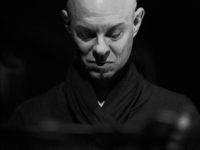The composer and pianist from Zurich by the name of Nik Bärtsch and his band Ronin have just this week released their second major-label record. And even with having had the benefit is listening to Holon for a few weeks, now, it’s hard to tell if this record is supposed to be a simple pleasure or cerebral contentment.
For you see, some jazz records are meant to be listened to carefully with attention paid to all the subtleties put into the music, and some are just groovers where you can enjoy more with your heart than with your mind. Holon is a groover, but in an ECM kind of way.
The “ECM” way means there’s attention to detail, recorded pristinely with every subtley captured. But this fabled record label of forward thinking, mostly in the form of European-inclined jazz, is making a very un-ECM-like appeal to your heart as well as your head. Holon is a collection of repeating figures that gradually evolve—think of The Necks with discernible, rhythms divided into 2’s and 3’s and shorter song forms. Ronin places minimalism on top of a foundation of funk on what Bärtsch himself calls “ritual groove music.”
Bärtsch’s tight little ensemble consists of himself on acoustic piano, Sha on bass clarinet and alto sax, Björn Meyer on six string electric bass and Andi Pupato on percussion. Sometimes it sounds more like a trio as Rast and Pupato play so closely together as to sound like a single unit, while Sha mainly blends in providing shadings and accents. With a nearly all-acoustic outfit, Ronin executes this ritual groove music to perfection.
The most extended track “Modul 41_17” is a good example of Ronin’s signature style (Bärtsch evidently is a fan of the Braxtonian song naming system). It begins with two notes played on the piano over and over. Meyer provides a low key, slinking bass solo but after that is done, the two notes gradually build up in intensity until the drums come in with a staggered rhythm for for a four note theme. Soon, the percussion drops out again and a different ostinato is introduced, building up to the same theme. After which an entirely different repeating sequence is introduced, but locked into a jungle groove. Bärtsch nimbly solos underneath it so that the insistent rhythm never leaves the listener’s focus. He and the percussionist Pupato playfully trade accents. In measured, barely perceptible fashion, the song fades out.
So clearly, the performances are built around the percussive effects of Rast, Pupato, Meyer and yes, even Bärtsch himself. That emphasis on the beat is well demonstrated by the YouTube video below; note in this live performance from last year (of what I believe might be “Modul 44”) and you will see the drummer Rast and bassist Meyer right at front center.
Ultimately, I’ve concluded that Holon is not a treat exclusively for the heart or mind, but for both. With records like Holon, Nik Bärtsch’s Ronin proves that a thinking person’s music can be quite accessible. And even quite funky.
- Christian Marien Quartett – ‘How Long Is Now’ (2024) - April 18, 2024
- Dave Douglas, feat. James Brandon Lewis – ‘Gifts’ (2024) - April 11, 2024
- Thollem – ‘Worlds In A Life, Two’ (2024) - April 8, 2024



